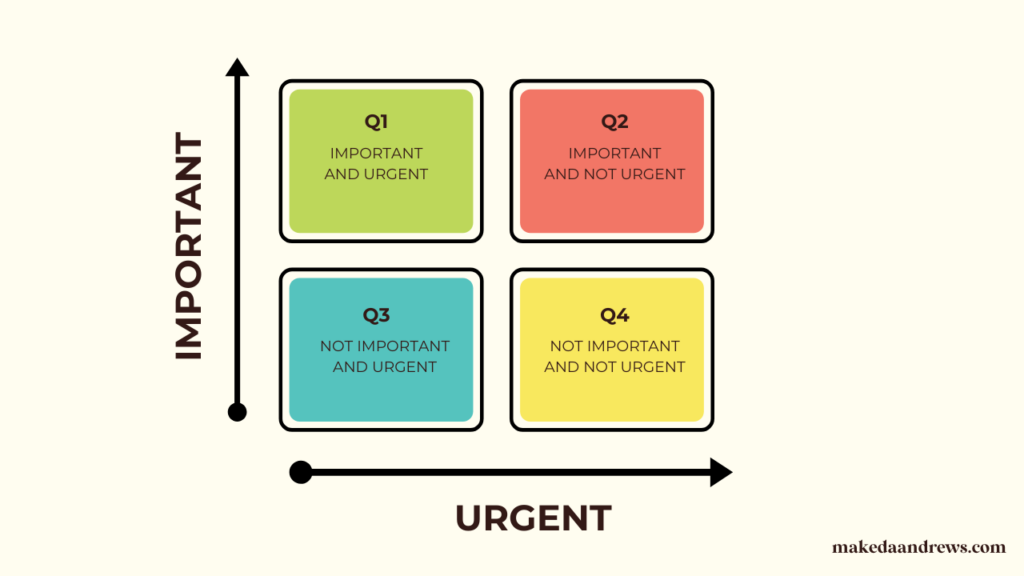The 4 Quadrants of Time Management For New Team Leaders
Hi, I'm Mak. I'm a leadership coach for new managers who knows what it's like to be filled with overwhelm, self-doubt and terror that I’d let everyone down. My Story
FREE MICROCAST
How to Become an Effective Leader so You Can Build a High Performance Team
Learn how to delegate with confidence, navigate those tricky conversations (even for introverts!), and finally stop relying on Google to do your job.
Netflix < MakTV
THE YOUTUBE CHANNEL
No but really. This is the kinda content that’s actually healthy to binge. In fact, you become more of an awesomesauce manager with every video you watch.
Updated November 21st, 2024
If you’re stepping into a leadership role for the first time, one of the most important skills you’ll want to develop is time management. It will save you lots of headaches and increase your productivity as a team.
So, in today’s blog post, I will reveal one great time-management strategy with you: the Four Quadrants of Time Management. Make sure to read until the end, as this approach will help you prioritize your tasks, get started on the right foot, and become a more effective and confident leader.
What’s the Secret? The Four Quadrants of Time Management
Most new managers I know are working overtime. **In fact, according to a survey by Clockify, 21.7% of leaders are working 60 hours per week.** That’s more than 20 extra hours per week you could use to relax, do self-care, or spend time with your family!
So, here’s what you need to be doing instead: Time-management.
There are several tools out there for managing your time, but my favorite one is The Four Quadrants of Time Management.
This tool has different names, such as the Eisenhower Matrix, Stephen Covey’s “Quadrants of Extraordinary Productivity,” or Dave Ramsey’s Time Management Matrix. They all combine tasks based on their importance and urgency.
I am going to show you a mash-up of these different methods. I’ve taken pieces from all these versions that I found helpful and implemented them into my work life to help me stay on track, focus, and ensure no tasks are missed.
As you can imagine, this tool has many benefits for your leadership journey, but I would like to narrow them down to two main ones:
- First, it will make you realize what you’re spending your time on the most.
- Second, perhaps most importantly, it will provide you with the information to make the necessary changes. Listen: change is only possible when you have the information to address it. So, with this information, you can start planning your time-management strategies and achieve a more productive and effective leadership.
So, let’s get to it.
Here is a quick look at the quadrant chart, divided by importance and urgency. I will go through each quadrant and explain what types of tasks fall into each area.

Quadrant #1: Important and Urgent
This quadrant is where we spend most of our time, which is unfortunate because this is a reactionary quadrant where everything placed here is important and urgent.
Focusing on these tasks all day long will leave you exhausted at the end of the day. You will feel like you had a chaotic day when you spit out fires. These tasks trigger your fight mode and cause you to stay in a reactionary zone.
Tasks in this quadrant might include:
- Meeting last-minute deadlines
- Sudden staffing changes
- An upset client that requires your attention
- A power outage
- An internet/ phone outage
Although the activities in this quadrant may look different for every industry and position, the general idea is the same for everyone. These are mainly important tasks that need to be dealt with immediately.
The Franklin Convey team did a study and found that 27% of people consistently spend their time in a reactionary state. So, if you relate to what I’m saying, you are in good company.

Quadrant 3: Not Important and Urgent
This is the quadrant of distraction; Dave Ramsey also calls it the quadrant of deception.
This is where tasks that are not important but urgent fall into. At this point, you might be thinking: How can something not be important and still be considered urgent?
An excellent example is when one of your team members comes to you with a problem that they need your help solving. Even if a problem may not be important to you, you must help your team members solve it urgently.
When you hold a leadership role, you may often find yourself in this situation. It could even involve:
- Attending meetings that aren’t all that important in the grand scheme of things (we’ve all attended a few of them!),
- Responding quickly to emails that aren’t that important
- Following up on tasks you’re not responsible for
The same study by Franklin Covey showed that we spend around 23% of our time in this quadrant, where we are constantly in a reactive mode, tending to things that are not necessarily important to us but do require action on our part.
Quadrant 4
This is the quadrant that represents waste/ default. It contains tasks that are not important and not urgent. Many people want to be productive but either get worn out from being in a reactionary state for too long or are unsure what to do next, so they start to engage in activities or tasks that don’t really matter or are not urgent at all.
I see this mistake with a lot of managers. They fall back into doing the tasks they did before they were managers out of sheer comfort when they should be delegating these tasks to their team members.
If this is you and you are ready to change your course of action, sign up for my FREE class, How to Become an Effective Leader so You Can Build a High-Performance Team, here!

Quadrant 2
This is the quadrant where you want to spend most of your time. It is also known as the quadrant of extraordinary productivity or, as Dave Ramsey calls it, the quadrant of leadership.
These tasks are important but not urgent, which makes them proactive.
You can fill this quadrant with tasks that help you create a strategic plan, such as:
- 1-on-1 meetings
- Developing yourself to improve your focus and gain control
- Learning how to help others develop within their roles
- Practicing self-care as a manager
I want to reinforce the importance of taking care of yourself in the workplace. It will allow you to get out of the reactionary state, recover, and not feel burnt out.
Spending more time on tasks in quadrant 2 will stop you from falling into the trap of always being in a reactionary mode, which, in turn, sets a great example for your team, encouraging them to stay proactive, too.
Your team reflects your leadership, and if you constantly react, so will they, leaving room for many mistakes.

The main takeaway I want you to have is that becoming a proactive leader and applying these time management strategies will help your team produce high-impact results.
If you’re ready to start making changes today, snag a FREE seat in my 5-pillar framework to become an effective leader with a high-performance mindset.
If you have any questions about this tool, comment below, and save this article whenever you need to get back to it.

February 11, 2020
[…] go a long way in pulling yourself out of a reactive state. I have another article about learning to prioritize your time for you to check out. I also included a chart below for you to skim over to see the difference […]